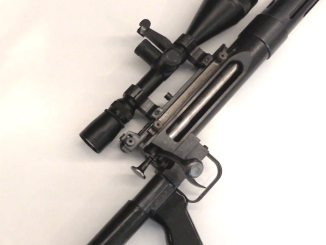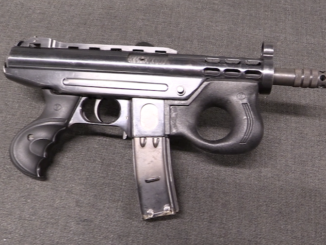The ALKA model 93 is one of the nicest of the several dozen simple SMGs made in Croatia during the Homeland War of the 1990s. It was produced by the IM Metal company (later renamed HS Produkt) starting in 1991, was formally adopted by the Croatian armed forces in 1993, and produced until 1994 or 1995. Several thousand were made in total, although I have not been able to find an exact number.
Mechanically, the Alka is a hybrid of the Ingram M10/M11 and the Czech vz.61 Skorpion. It is chambered for 9mm Parabellum and uses a telescoping bolt and recoil system copied directly from the Ingram. The bolt travel is quite short, and the rate of fire is quite high; approximately 1200 rpm. The receiver is a square tube made by folding flat sheet metal over a mantle and seam welding it together. The stock is copied directly from the vz.61, although it is longer and thus more comfortable to use. The magazine is a proprietary single-feed type, but again clearly copied from the MP40.
Thanks to HS Produkt in Croatia for inviting me into their factory and providing this example of the Alka for me to film!
Other Croatian Homeland War SMGs:
Šokac: https://youtu.be/d82b4xb6bAA
Agram 2000: https://youtu.be/jfC1hrr46Ps




Appears to be a very small Form factor, possibly smaller and lighter than a Stechin?
Is better, high rate of fire in bursts or slow rate of fire in a heavier weapon?
“(…)smaller(…)than(…)Stechin?”
I assume Stechin is show of disdain toward designer of APS, if this does not hold true ignore reply entirely.
According to https://www.armedconflicts.com/Alka-M-93-t119390 Alka’s length is 630 mm / 338 mm (stock open/closed), whilst according to https://modernfirearms.net/en/handguns/handguns-en/russia-semi-automatic-pistols/stechkin-aps-selective-fire-eng/ APS length is 225 mm, thus latter weapon is shorter.
I hope I wasn’t misunderstood. It appeared to me to be smaller than the Stechin, I was relying on my faulty memory. No disparagement meant towards the weapon or it’s designer.
Now, which is considered more controllable, high-rate-of-fire in short bursts from light weapon or
low rate-of-fire in heavier weapon?
Man behind nick “Daweo” is sensitive to proper pronunciation/ spelling of weapons and their designers. The name of designer is STECH-KIN, not Stech-in. Minor, but important. You do nor want your name mispronounced, right?
I do not see much Skorpion-ish on this creation. The core of Skorpion is its rate reducer; everything else is peripheral. Besides, it does not feed thru the grip.
Looking at images it seems more akin to another Czechoslovak-made fire-arm namely Sa.25 https://modernfirearms.net/en/submachine-guns/czech-republic-submachine-guns/sa-23-eng/
– magazine extends beyond (below) grip
– stock could be used in lieu of front grip when folded
– cocking handle is sticking upward
Check! (= call of assurance/ agreement in continental English)
Just in the cause of historical pickiness, the Croations (and Bosnians and briefly the Slovenes) were fighting the Yugoslav national army, controlled from Belgrade. Technically the Yugoslav army was fighting to preserve Yugoslavia from the various independence movements but it is argued (by Croations, Bosnians, and Slovenes) that they were fighting to preserve Serb hegemony over (and exploitation of) the multiple republics. I cannot speak about the various Serbian militias involved in the conflict, nor what is nowadays the Serbian army.
You are not wrong with your super-short assessment. I would add (and I not belong to any involved nationality) that Yugoslavia was partly natural and partially artificial creation. The weak point was that country’s dependence on western financial system (loans). Once its currency (due to that dependency) crumbled, they country was in shambles. Old rivalries unraveled.
Yes, Yugoslav national army was trying o maintain unity, while the splinter national groupings/ movements we truing just the opposite. Neither side one can be blamed solely on rational bases alone. It involved primarily long lasting frozen emotional rifts and wounds of the past. Five nationalities, there major religions are hard to incorporate in one single state.
The old Yugoslavia was fairly prosperous and independent (I visited there twice and knew the language), now the all descendant republics struggle for bare existence. Qui bono? Who is the real winner?
sorry for typos; it should be:
Yes, Yugoslav national army was trying to maintain country’s unity (it had a mandate to do so), while the splinter national groupings/ movements we doing just the opposite. Neither side can be blamed solely on rational bases alone. It involved primarily long lasting frozen emotional based rifts and wounds of the past.
Five nationalities, three major religions are hard to incorporate into one single state.
Seceding from Yugoslavian federation was a democratic, constitutional right that 2 of the westernmost republics exercised by more than 90% citizen vote.
YNA was in the beginning maybe split between insane and redundant idea independence should be stopped and republics “brought back”, restoring one big happy family of many nations, 3 religions and 2 scripts; and a greater Serbia idea where they would occupy as much of foreign territories as they can, to be in the future joined, or at least governed, by Serbia and Montenegro.
Soon pro-yugoslavian officers that werent serbian extreme nationalists (btw. vast majority of all officers were Serbs by nationality, they dominated the YNA in all its history- but not all of them were extremists) were cleansed from the YNA,
and it was instrumentalized by politicians solely into aggressive, expansionist pro-serbian function, that culminated with all-out war in Croatia in fall of 1991.
I’ve mentioned it before, but it was by huge degree similar to what is happening in Ukraine today, with Donbass and other places, where Russian propaganda states they come to “free” the ukrainian people, in similar manners during 1991. YNA proclaimed it comes to “free” the peoples of seceded republics, from their “evil, neonazi governments”.
Also, both aggressor cases are similar that they suffer from incomplete mobilization and problems with recruitment – YNA in 1991. had frightening amount of both light and heavy ordnance, but not enough conscripts, as people from other republics and even Serbia boycotted it by a degree, not freely wanting to wage war on former “broterhood and unity” republics (like it is today with former USSR brotherly people, Russians and Ukrainians)
So, in the end you had a situation where aggressor was armed to the teeth, but lacking enough manpower to just walk in and “pacify” everything like what USSR did in its interventions in Hungary and ČSSR crushing any oppostion,
and defenders that were numerous, but very lightly armed, lacking even small arms, but sufficiently resisting, almost fanatically to keep the aggressor from claiming strategic goals. Though it was very near of being a bloodbath, and it actually was for many civilians (in Croatia, more civilians were killed, then soldiers, but even worse in Bosnia/Herzegovina, where it exploded into insanity of ethnic cleansing and genocide, there, muslims/”bosniaks” were one that were most lacking in armaments and in worst position – go figure what happened to them; complete villages and towns of unarmed civilians were massacred)
Had the western Europe countries and USA chose to intervene by some degree (air force bombardments) in Yugoslavia, or at least send armaments like they are sending today to Ukraine, YNA would be kicked out of Croatia and Bosnia and Herzegovina by the end of 1992. and there wouldnt be a third of destruction and victims like it happened with war that lasted up to 1995. (even after that, up to 1999. there was a possibility and danger of new flare ups)
But, geopolitics are a wicked game, and they chose to stand by and watch, all having their particular interests – because Yugoslavia apparently is not oil-rich Kuwait.